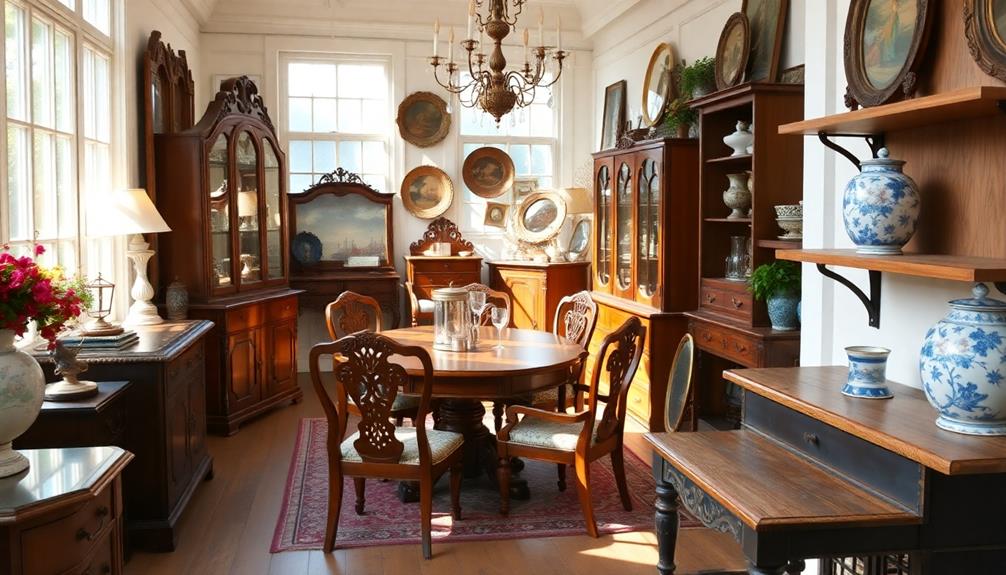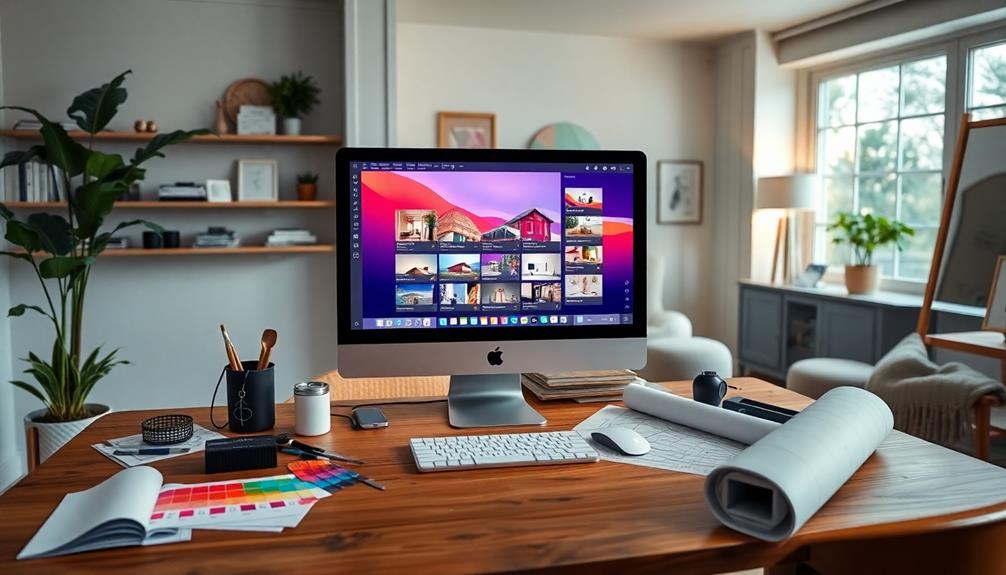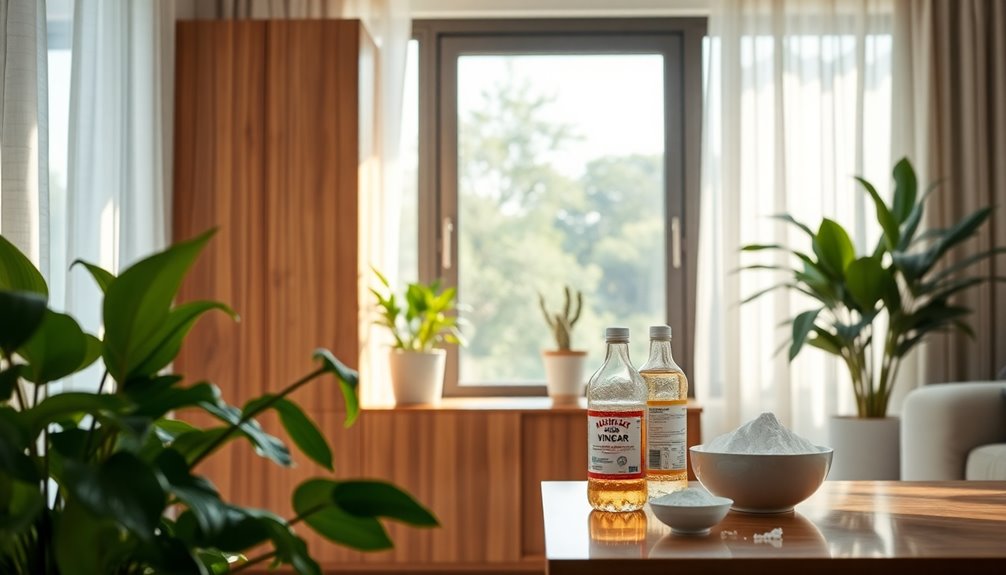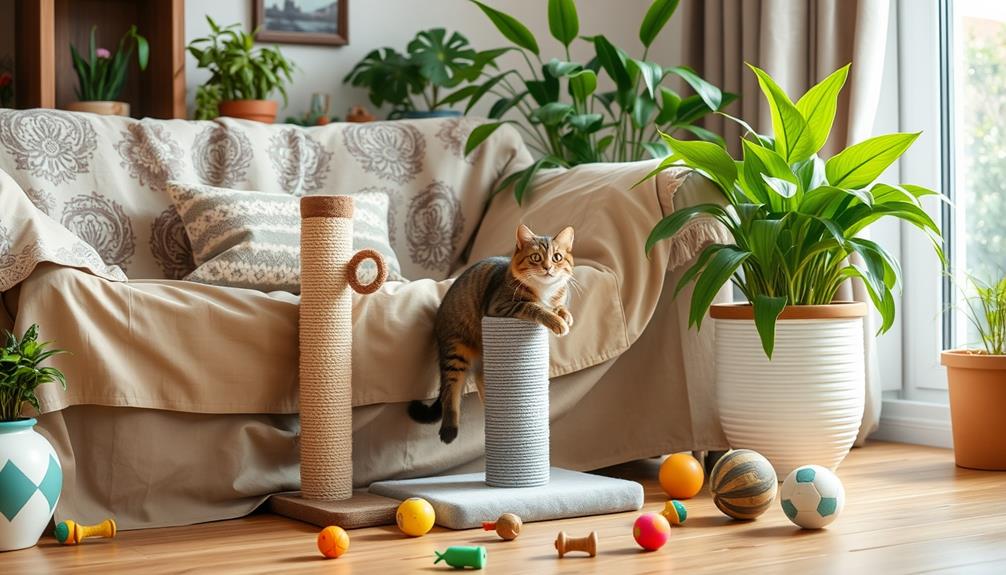To effectively sell antique furniture, it is important to ensure its authenticity first. Look for indications of age and manufacturer’s marks. Then, perform thorough research on the market to establish a competitive price based on the item’s condition and rarity. Carefully select the platform for selling, whether it be online marketplaces, local antique stores, or auction houses. Create detailed listings that showcase the unique qualities and provenance of the piece. High-quality photographs are crucial: use natural lighting, capture various angles, and emphasize intricate details. Lastly, establish trust with potential buyers by providing documentation. There is much more to learn about maximizing sales and effectively reaching buyers, so let’s delve deeper.
Key Takeaways
- Verify authenticity by identifying age through furniture marks and documentation to establish credibility.
- Conduct market research to determine a competitive price based on condition, rarity, and demand.
- Choose appropriate selling platforms like online marketplaces, antique stores, or auction houses for wider reach.
- Create detailed listings with descriptions highlighting age, maker, unique features, and provenance to attract buyers.
- Utilize quality photography techniques, focusing on natural light and multiple angles to showcase the furniture effectively.
Understanding Antique Furniture
Antique furniture holds a unique charm that can transform any space, but understanding what qualifies as antique is essential before you plunge into selling. To be considered antique, furniture must be over 100 years old, encompassing various types like seating, storage, and tables.
You'll want to familiarize yourself with the key differences between antique and vintage items; antiques refer to pieces from before the 1940s, while vintage includes those that are 20-30 years old. Additionally, it's important to recognize that the selling process may involve understanding financial terms related to valuation and investment, such as investment regulations that could affect your sale.
When you're evaluating antique furniture, keep in mind that its value hinges on age, condition, and design desirability. Pieces in excellent condition are particularly attractive to collectors.
It's also vital to know that collectors often seek specific eras or styles, such as Victorian antiques or mid-century modern pieces, which can help you target the right buyers.
To authenticate and accurately value your antique furniture, make sure you identify any furniture marks and understand the historical context. This knowledge not only enhances your selling strategy but also assures potential buyers of the piece's authenticity and value.
The Appeal of Antiques

When you choose antique furniture, you're embracing a timeless quality that modern pieces often lack.
The charm of vintage and antique furnishings can enhance your home decor, creating a cozy atmosphere that reflects your personality.
These unique items not only enhance your home decor but also promote sustainability by reducing waste and encouraging reuse.
With each piece, you connect to a rich history while adding character to your living space, often aligning with current modern farmhouse decor trends that emphasize natural materials and authenticity.
Timeless Quality Appeal
The allure of timeless quality in antique furniture captivates collectors and decorators alike, drawing them to pieces that embody unique craftsmanship and historical significance. When you're selling antique furniture, this timeless appeal plays an essential role in attracting buyers. They appreciate the artistry and durability that antiques offer, setting them apart from mass-produced items that fill modern homes.
Additionally, just as juice diets can impact health, the investment in antique furniture can greatly enhance the aesthetic and emotional value of a living space. Antiques tell stories and reflect personal tastes, allowing you to create spaces that are both beautiful and meaningful. Whether it's a Victorian chair or a mid-century modern table, the distinct styles resonate with those looking to enhance their decor.
As you navigate the selling process, emphasize these unique characteristics to connect with potential buyers. Moreover, owning antiques fosters a sense of community and environmental responsibility. By choosing to invest in these pieces, buyers engage in a sustainable practice that promotes reuse and reduces waste.
Highlighting this aspect can elevate the appeal of your offerings. Ultimately, when selling antique furniture, focus on the timeless quality and historical significance, as these elements not only attract collectors but also enrich homes with lasting beauty and character.
Sustainable Home Decor
In today's world, where sustainability is more important than ever, antique furniture stands out as a compelling choice for eco-conscious decorators. By opting for antique pieces, you promote reuse and reduce waste, providing durable alternatives to mass-produced items. This aligns perfectly with the growing trend of valuing craftsmanship and individuality in sustainable home decor.
Here's a quick look at why choosing antiques is a smart choice:
| Reason | Benefit | Emotional Impact |
|---|---|---|
| Reuse | Reduces environmental impact | Pride in eco-friendly choices |
| Unique Design | Enhances personal style | Connection to history and artistry |
| Timeless Quality | Lasts for generations | Comfort in long-lasting value |
| Circular Economy | Fosters sustainable practices | Sense of belonging to a tradition |
| Counter Fast Fashion | Supports thoughtful purchasing | Satisfaction in meaningful investments |
When you embrace antiques, you not only create a beautiful living space but also contribute to a more sustainable future. So, if you're looking to sell your vintage pieces, remember that their value extends beyond mere dollars. They carry stories and sustainability, appealing to today's conscious consumers.
Steps for Selling Antique Furniture
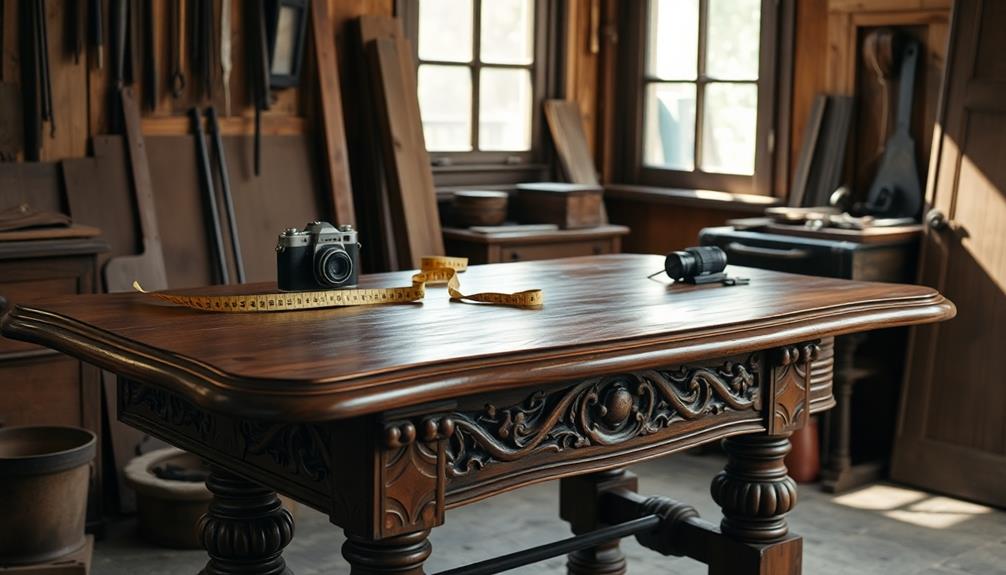
Selling antique furniture can be a rewarding endeavor, but it requires careful attention to detail. First, identify the age of your piece using historical knowledge and verify its authenticity through furniture marks or documentation. This step is essential in building trust with potential buyers.
Next, conduct thorough market research to determine a competitive price. Consider factors like condition, rarity, and demand, as these will influence what buyers are willing to pay.
Once you've set your price, choose the right selling methods. Depending on your target audience, you might opt for online platforms, antique markets, or auctions to maximize exposure.
Prepare detailed descriptions of your item, highlighting its age, maker, and unique features. If you have any provenance or documentation that supports authenticity claims, make sure to include that as well; it can greatly enhance your piece's appeal.
Photography Tips for Listings
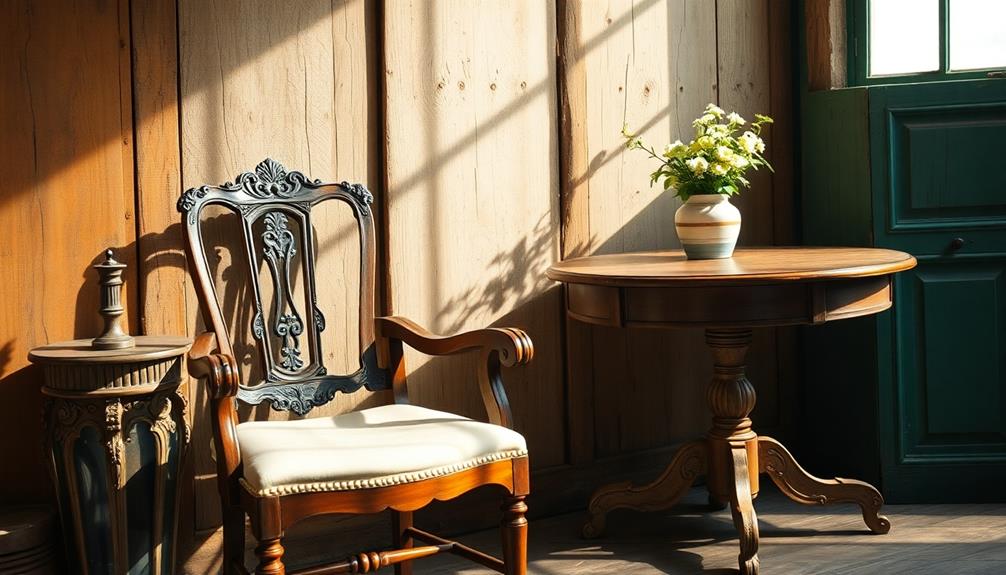
When photographing your antique furniture, always use natural light to highlight its colors and intricate details without casting harsh shadows. Position your furniture near a large window or shoot during the early morning or late afternoon when the sunlight is softer. This will help capture the craftsmanship and texture of the wood or upholstery. If you’re documenting the process of refinishing, consider looking up tips on how to paint furniture to achieve a flawless finish that pops in your photos.
Make sure to capture multiple angles, including the front, back, and sides, so potential buyers can see every aspect of the piece.
This approach not only showcases the furniture effectively but also builds trust with your audience.
Natural Lighting Importance
Natural lighting plays an essential role in showcasing antique furniture effectively in photographs. When you utilize natural light, the colors and textures of your furniture come alive, making them look more vibrant and appealing.
To achieve the best results, aim to take your photos during the golden hour—shortly after sunrise or before sunset. This time provides soft, diffused light that minimizes harsh shadows while highlighting intricate details.
Avoid using direct flash, as it can create glare and distort the wood's true appearance, detracting from its beauty. Instead, position your furniture near a window or outdoors in shaded areas. This way, you'll harness natural light without risking overexposure.
While taking pictures, capture multiple angles and close-ups of your furniture. Highlighting intricate details such as carvings or hardware is vital for attracting potential buyers.
Multiple Angles Capture
Capturing multiple angles of your antique furniture is essential for providing potential buyers with a thorough view of the piece. This approach not only showcases its beauty but also builds trust with your audience.
When selling your furniture, follow these photography tips to enhance your listings:
- Diverse Perspectives: Photograph the front, back, sides, top, and bottom of the piece. This extensive coverage allows buyers to assess its condition and features effectively.
- Close-Up Details: Include close-up shots of intricate design features, maker's marks, and any imperfections. Transparency is key in attracting discerning collectors who appreciate authenticity.
- Neutral Background: Use an uncluttered, neutral background to keep the focus on the furniture. This helps your piece stand out, making it more appealing in the images.
Selling Platforms and Opportunities
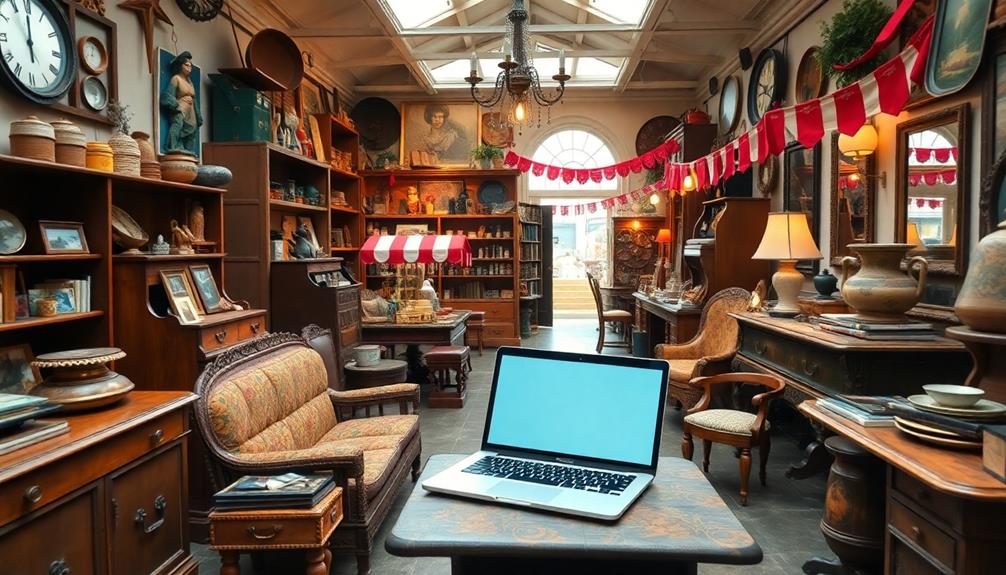
Frequently exploring various selling platforms can greatly enhance your chances of successfully selling antique furniture. Each option offers unique advantages, so consider where your vintage furniture pieces might shine the most.
| Platform Type | Pros | Cons |
|---|---|---|
| Online Marketplaces | Wide reach, easy listings | High competition |
| Local Antique Stores | Direct buyer interaction | Limited audience |
| Auction Houses | Competitive bidding potential | Fees can reduce profits |
Online marketplaces like eBay, Etsy, and Ruby Lane attract collectors and enthusiasts, giving your pieces a global audience. For those wanting a personal touch, local antique stores and antique malls allow you to engage with buyers directly. If you're aiming for higher sale prices, auction houses like Sotheby's can create excitement and competition around your antique pieces.
However, if you're looking for a quick sale, consider thrift stores, flea markets, or garage sales. These options might not yield the best profits, but they can help you move unwanted items swiftly. By understanding these platforms, you'll increase your chances of successfully selling your antique furniture.
Benefits of Antique Malls
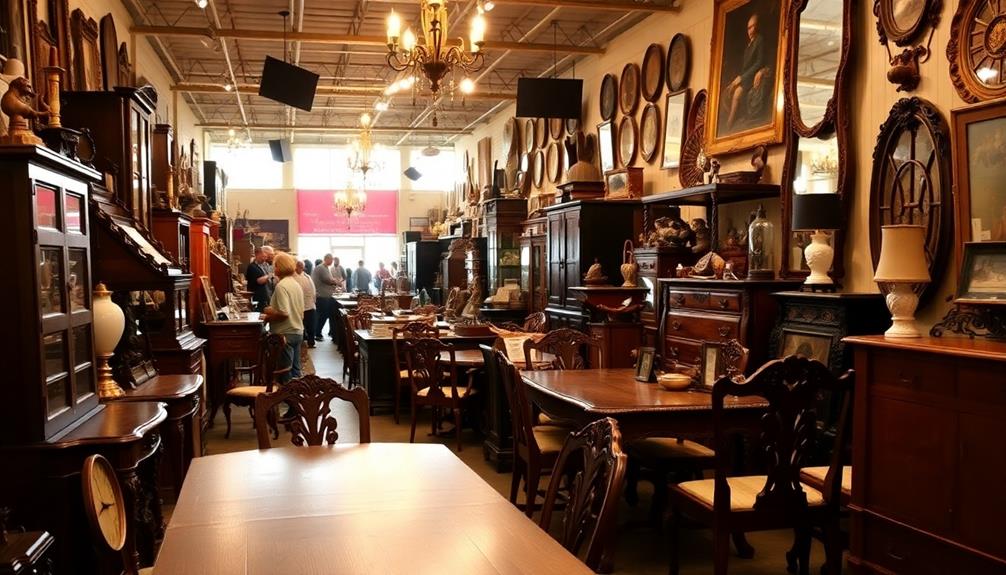
Selling antique furniture at antique malls offers several notable benefits that can enhance your experience and success.
These vibrant spaces not only attract buyers but also create a supportive environment for sellers like you. Here are three key advantages of selling at antique malls:
- Networking Opportunities: You'll have the chance to connect with nearby vendors, fostering community ties that can lead to collaboration and shared customer bases.
- Vendor Support: Antique malls often provide retail assistance, making it easier for new sellers to navigate the market and understand customer preferences.
- Enhanced Visibility: Participating in store events and activities can considerably boost your sales, as these events draw in more customers who mightn't have otherwise visited.
Additionally, having a booth allows you complete control over your merchandise presentation, making your items more appealing.
Plus, many antique malls feature easy online inventory systems that help you manage your sales and track performance seamlessly.
Establishing a Vintage Furniture Business

Establishing a vintage furniture business can be an exciting venture filled with opportunities for creativity and profit. Before you engage, research valuable furniture and maker's marks to identify pieces with high resale potential. Knowing what's in demand can help you sell effectively.
Understand market trends and pricing strategies; this knowledge greatly influences your sales. Join a community of vendors in antique malls to gain support and collaborate on marketing efforts. Sharing resources can enhance your business visibility.
Create a detailed inventory list with clear pricing and descriptions. Transparency is key; customers appreciate having all necessary information about the pieces you sell.
Setting up an appealing booth in an antique mall is essential. Use unique design choices to attract customers and differentiate your offerings from competitors. Make your display inviting and reflective of your style to draw in buyers.
Valuation of Antique Furniture
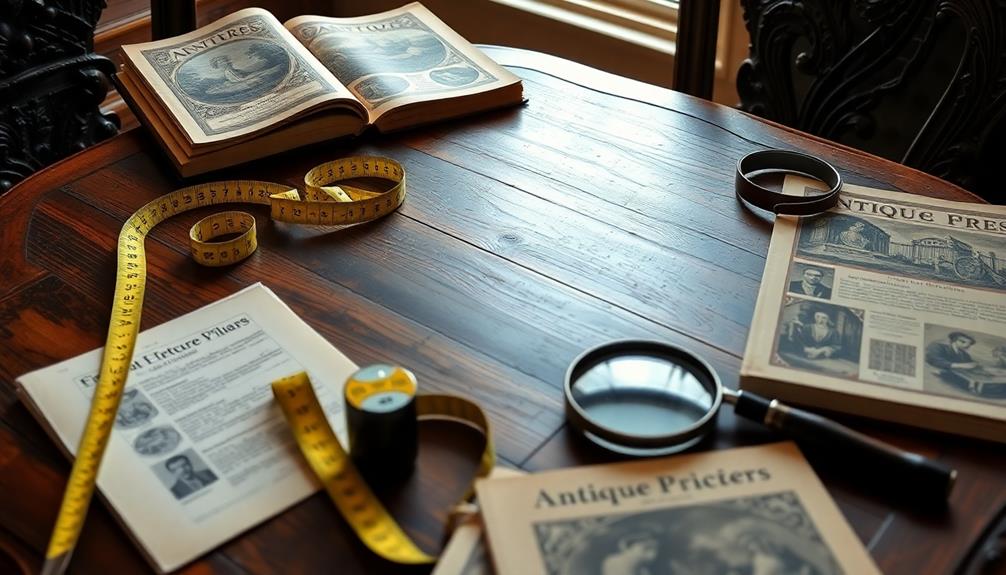
Valuing antique furniture accurately is essential for maximizing your profits and ensuring you don't undersell your pieces. To achieve a reliable valuation of antique furniture, consider these approaches:
- Professional Appraisals: Hiring an expert can provide precise estimates based on condition, rarity, and the current market for antiques. Expect to pay between $200 and $400 per hour for these services.
- Online Appraisal Services: For a more budget-friendly option, platforms like Sotheby's and WorthPoint offer evaluations starting at just $10 to $20 per piece. This can be a quick way to gauge your item's worth.
- Local Auction Houses: Many auction houses conduct free verbal appraisals on designated valuation days. This gives you an opportunity to understand your item's value without any financial commitment.
Additionally, don't forget to research current market trends. Using advanced search features on platforms like eBay can help you find completed sales of similar items.
Selling Process With Sotheby's
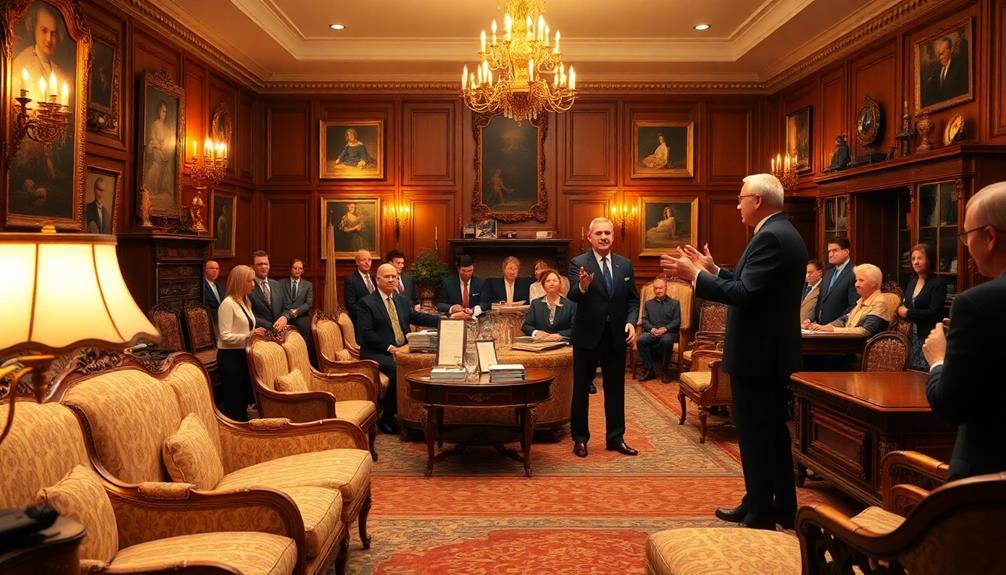
When you choose to sell your antique furniture through Sotheby's, you tap into a prestigious auction house with a global reach and expert insights.
The selling process begins with a free auction estimate appraisal. You simply fill out an online submission form, allowing specialists to provide you with a preliminary valuation based on your piece's condition, ownership history, rarity, and market demand.
Once you receive your estimate, you can decide whether to proceed with the auction. Sotheby's hosts events in major cities like Paris, London, and New York, ensuring your local antique gains maximum exposure to collectors worldwide.
Their decades of experience in antique appraisal and sales considerably enhance your chances of a successful sale.
After your item sells, Sotheby's takes care of shipping logistics, ensuring your antique is transported safely to its new owner.
This streamlined process not only alleviates stress but also allows you to focus on the excitement of selling your valuable piece.
Frequently Asked Questions
How Do I Know if My Antique Furniture Is Valuable?
To know if your antique furniture's valuable, check its age, condition, and maker's mark. Research completed sales online and consider getting a professional appraisal for an accurate estimate based on current market trends.
What Is the Best Website to Sell Antique Furniture?
About 60% of online shoppers prefer platforms like eBay or Etsy for vintage items. You should consider these sites to sell your antique furniture, as they offer broad audiences and user-friendly tools for listing your pieces.
What Is the Best Way to Sell an Antique?
To sell an antique effectively, research its history, condition, and market demand. Clean and photograph it well, then use online platforms or local auctions to reach potential buyers. Engage them with compelling stories about the piece.
How Do I Sell an Expensive Piece of Furniture?
Selling an expensive piece of furniture is like crafting a fine dish; you need quality ingredients. Research its value, present it beautifully, target the right platforms, and be prepared to negotiate for the best price. Additionally, understanding *how to price secondhand furniture* appropriately is crucial in determining its market value. Consider factors like condition, brand, age, and demand while setting your price. Lastly, patience and persistence will help you achieve a fair transaction, ensuring both buyer and seller are satisfied with the deal. Pricing used furniture effectively can sometimes be a delicate balancing act, as you want to come across as fair without underselling the value of your piece. Stay open to reasonable offers but hold firm when you know the item’s worth, ensuring both parties walk away feeling they’ve struck a good bargain.
Conclusion
Selling antique furniture can be a satisfying journey if you follow the steps outlined. By showcasing your unique pieces and tapping into the timeless appeal of antiques, you can attract buyers and boost your profits. Whether you choose to sell online or in person, remember to present your treasures with pride. So, immerse yourself in the delightful world of antiques, and enjoy the rewarding experience of turning your cherished collectibles into cash!
